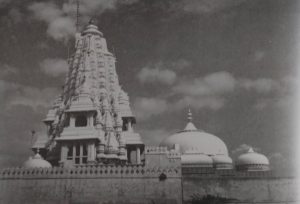Bikaner
 The desert city of Bikaner was founded, with the valuable help of Jaina families, in 1488, at a time when in north India Indo-Islamic art had firmly established itself. The best known and best preserved four Jaina temples situated at the eastern outskirts of the city are important examples of this period. It is mainly their interior which shows Islamic influence, whereas their exterior is still dominantly Indian.
The desert city of Bikaner was founded, with the valuable help of Jaina families, in 1488, at a time when in north India Indo-Islamic art had firmly established itself. The best known and best preserved four Jaina temples situated at the eastern outskirts of the city are important examples of this period. It is mainly their interior which shows Islamic influence, whereas their exterior is still dominantly Indian.
As these temples are partly hidden behind walls, it is the so-called Havelis (privately owned mansions) which at first catch the attention of the sightseeing visitor to Bikaner. How many private Jaina shrines there might be in these palace-like buildings can only be guessed.
which at first catch the attention of the sightseeing visitor to Bikaner. How many private Jaina shrines there might be in these palace-like buildings can only be guessed.
Their number may well go into the hundreds. According to the census of 1971 there were 18,266 Jainas (mostly Shvetambara) among the 188,518 inhabitants of Bikaner (V.A. Sangave Jaina Society Through the Ages, Delhi, 1992: 31).
With the re-modelling, in 1994, of a large Haveli into a first-class hotel by an old Bikaner Jaina family, in the process of which care was taken to retain the character and charm behind the fantastic façade, overseas visitors are offered the opportunity
 Bikaner. Bhandasar Temple, sacred to Parshvanatha. Building began early in the six- teenth century by a merchant named Bhanda. An outstanding example of Indo-Islamic architecture.
Bikaner. Bhandasar Temple, sacred to Parshvanatha. Building began early in the six- teenth century by a merchant named Bhanda. An outstanding example of Indo-Islamic architecture.
of experiencing and enjoying the atmosphere of a historical Jaina residence. There is a chapel with exquisite Jina statuettes and murals, a library with books on Jainism, a restaurant in which pure vegetarian food is prepared and served, and there is, wherever one looks, locally produced art of a very high standard (for address see appendix).
Altar in the private chapel of the Bikaner Jaina Hotel in the centre of the old city.
Beautifully designed balconies open out to the inner courtyard of this Bikaner Haveli, now a hotel run on Jaina values.